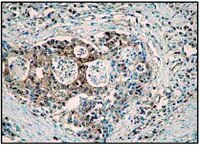The PIDDosome mediates delayed death of hippocampal CA1 neurons after transient global cerebral ischemia in rats.
Kuniyasu Niizuma,Hidenori Endo,Chikako Nito,D Jeannie Myer,Gab Seok Kim,Pak H Chan
Proceedings of the National Academy of Sciences of the United States of America
105
2008
Show Abstract
A brief period of global brain ischemia, such as that induced by cardiac arrest or cardiopulmonary bypass surgery, causes cell death in vulnerable hippocampal CA1 pyramidal neurons days after reperfusion. Although numerous factors have been suggested to account for this phenomenon, the mechanisms underlying it are poorly understood. We describe a cell death signal called the PIDDosome, a protein complex of p53-induced protein with a death domain (PIDD), receptor-interacting protein-associated ICH-1/CED-3 homologous protein with a death domain (RAIDD), and procaspase-2. We induced 5 min of transient global cerebral ischemia (tGCI) using bilateral common carotid artery occlusion with hypotension. Western blot analysis showed that expression of twice-cleaved fragment of PIDD (PIDD-CC) increased in the cytosolic fraction of the hippocampal CA1 subregion and preceded procaspase-2 activation after tGCI. Caspase-2 cleaved Bid in brain homogenates. Co-immunoprecipitation and immunofluorescent studies demonstrated that PIDD-CC, RAIDD, and procaspase-2 were co-localized and bound directly, which indicates the formation of the PIDD death domain complex. Furthermore, we tested inhibition of PIDD expression by using small interfering RNA (siRNA) treatment that was initiated 48 h before tGCI. Administration of siRNA against PIDD decreased not only expression of PIDD-CC, but also activation of procaspase-2 and Bid, resulting in a decrease in histological neuronal damage and DNA fragmentation in the hippocampal CA1 subregion after tGCI. These results imply that PIDD plays an important role in procaspase-2 activation and delayed CA1 neuronal death after tGCI. We propose that PIDD is a hypothetical molecular target for therapy against neuronal death after tGCI. | 18845684
 |









